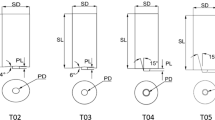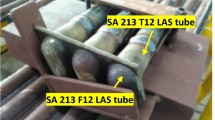Abstract
Thermal residual stress is an undesirable and unavoidable phenomenon in welding structures. It causes distortion of the weld and reduces the weld’s mechanical properties. In the present study, a new setup of friction stir welding process including cooling of weld nugget was developed to enhance the weld strength and to reduce the angular distortion of the friction stir welded polyethylene sheets. The clamped sheets are firstly welded by FSW process, and then, the traversed weld nugget is cooled by injection of CO2 gas. Here, Taguchi experimental design and response surface methodology were used to analyze effects of tool rotary speed, traverse speed, and cooling gas intake pressure on tensile strength and angular distortion. Also, the nondestructive ultrasonic evaluation was used here to measure residual stress to justify variation of angular distortion. Obtained results revealed that applying cooling causes better consolidation of plasticized material; also, it causes releasing residual stress and decreases the angular distortion.
Similar content being viewed by others
References
Kiss Z, Czigány T (2007) Applicability of friction stir welding in polymeric materials. Period Polytech 51(1):15–18
Mishra RS, Ma ZY (2005) Friction stir welding and processing. Mater Sci Eng R Rep 50(1):1–78
Simões F, Rodrigues DM (2014) Material flow and thermo-mechanical conditions during Friction Stir Welding of polymers: literature review, experimental results and empirical analysis. Mater Des 59:344–351
Mendes N, Loureiro A, Martins C, Neto P, Pires JN (2014) Effect of friction stir welding parameters on morphology and strength of acrylonitrile butadiene styrene plate welds. Mater Des 58:457–464
Panneerselvam K, Lenin K (2014) Joining of Nylon 6 plate by friction stir welding process using threaded pin profile. Mater Des 53:302–307
Bozkurt Y (2011) The optimization of friction stir welding process parameters to achieve maximum tensile strength in polyethylene sheets. Mater Des 35:440–445
Hoseinilaghab S, Mirjavadi SS, Sadeghian N, Jalili I, Azarbarmas M, Besharati Givi MK (2015) Influences of welding parameters on the quality and creep properties of friction stir welded polyethylene plates. Mater Des 67:369–378
Sadeghian N, Besharati Givi MK (2015) Experimental optimization of the mechanical properties of friction stir welded Acrylonitrile Butadiene Styrene sheets. Mater Des 67:145–153
Bagheri A, Azdast T, Doniavi A (2013) An experimental study on mechanical properties of friction stir welded ABS sheets. Mater Des 43:402–409
John R, Jata KV, Sadananda K (2003) Residual stress effects on near-threshold fatigue crack growth in friction stir welds in aerospace alloys. Int J Fatigue 25:939–948
Bussu G, Irving PE (2003) The role of residual stress and heat affected zone properties on fatigue crack propagation in friction stir welded 2024-T351 aluminium joints. Int J Fatigue 25:77–88
Khandkar MZH, Khan JA, Reynolds AP, Sutton MA (2006) Predicting residual thermal stresses in friction stir welded metals. J Mater Process Technol 174:195–203
Woo W, Choo H, Brown DW, Feng Z (2006) Liaw KP (2006) Angular distortion and through-thickness residual stress distribution in the friction-stir processed 6061-T6 aluminum alloy. Mater Sci Eng A 437:64–69
Riahi M, Nazari H (2011) Analysis of transient temperature and residual thermal stresses in friction stir welding of aluminum alloy 6061-T6 via numerical simulation. Int J Adv Manuf Technol 55:143–152
Bilici MK, Yukler AI, Kurtulmus M (2011) The optimization of welding parameters for friction stir spot welding of high density polyethylene sheets. Mater Des 32:4074–4079
Deng D (2009) FEM prediction of welding residual stress and distortion in carbon steel considering phase 8-Dean Deng”, FEM prediction of welding residual stress and distortion in carbon steel considering phase transformation effects. Mater Des 30:352–366
Bergman RM, Shahbender RA (1958) Effect of statically applied stresses on the velocity of propagation of ultrasonic waves. J Appl Phys 29:1736–1738
Ahmadnia M, Seidnaloo A, Teimouri R, Rostamiyan Y, Tittash K (2014) Determining influence of ultrasonic-assisted friction stir welding parameters on mechanical and tribological properties of AA6061 joints. Int J Adv Manuf Technol. doi:10.1007/s00170-015-6784-0
Babajanzade S, Behboodi-Jooybari M, Teimouri R, Asgharzade-Ahmadi SGH, Falahati-Naghibi M, Sohrabpoor H (2014) Optimization of friction stir welding process of AA7075 aluminium alloy to achieve desirable mechanical properties using ANFIS models and simulated annealing algorithm. Int J Adv Manuf Technol 69(5-8):1803–1818
Sohrabpoor H, Parasa Khanghah S, Shahraki S, Teimouri R (2015) Multi-objective optimization of electrochemical machining process. Int J Adv Manuf Technol. doi:10.1007/s00170-015-7448-9
Author information
Authors and Affiliations
Corresponding author
Rights and permissions
About this article
Cite this article
Nateghi, E., Hosseinzadeh, M. Experimental investigation into effect of cooling of traversed weld nugget on quality of high-density polyethylene joints. Int J Adv Manuf Technol 84, 581–594 (2016). https://doi.org/10.1007/s00170-015-7663-4
Received:
Accepted:
Published:
Issue Date:
DOI: https://doi.org/10.1007/s00170-015-7663-4




